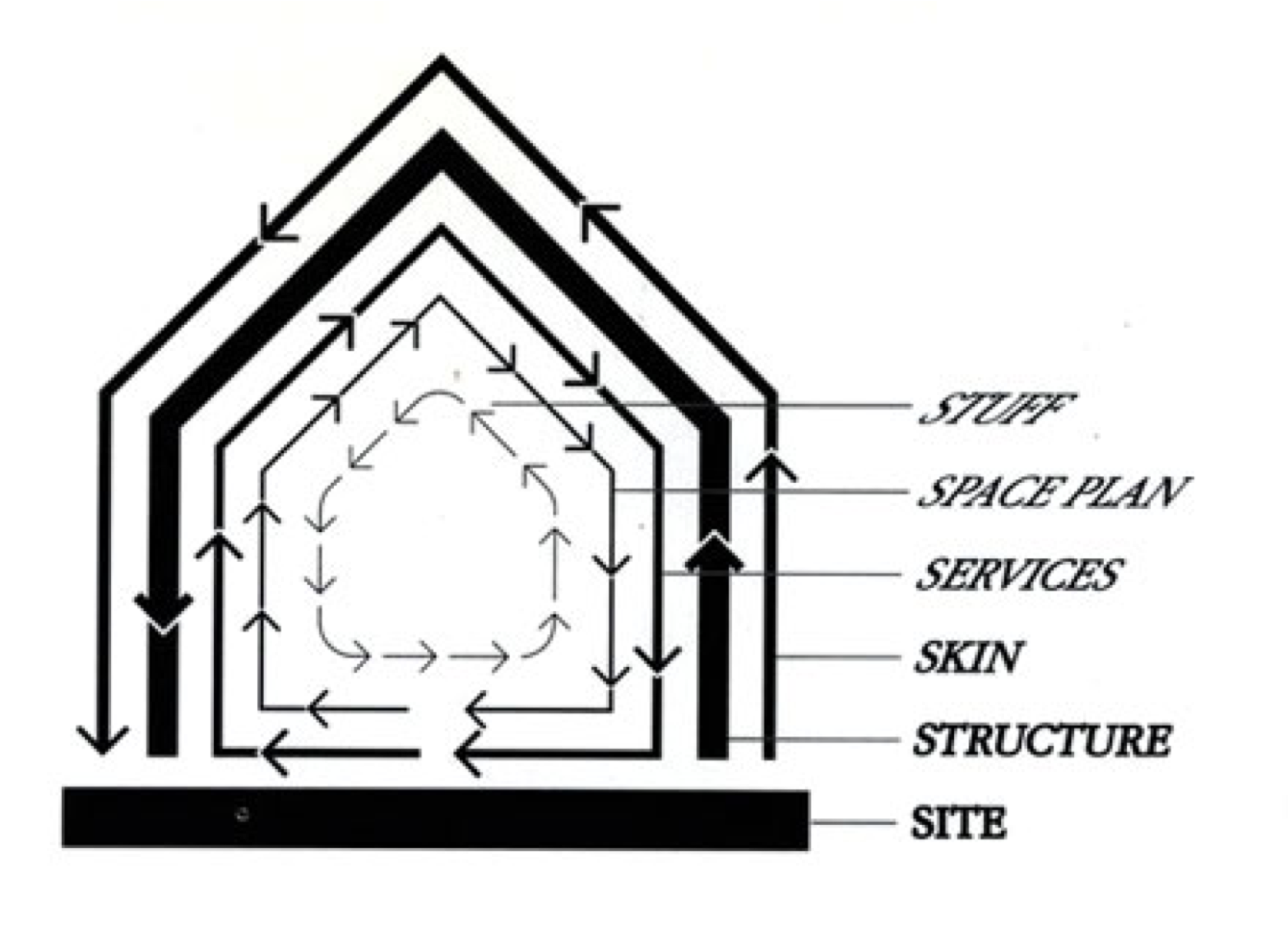As someone who cares about the longevity of systems, I love Stewart Brand’s Pace Layer model. In case you’re unfamiliar with the idea, the Pace Layer model explains how complex systems change over time. Such systems don’t change uniformly; instead, they’re composed of elements that vary in scale and rates of change.
The model has roots in architecture, and that’s how I usually introduce it. Mr. Brand’s book How Building’s Learn presents the following version, which is based on the work of architect Frank Duffy:

This ‘architectural’ version of the model proposes six layers of elements that compose a building. From the fastest-changing to the slowest, they are:
- Stuff, furnishings which can be moved around by occupants,
- Space plan, the internal divisions between spaces,
- Services, such as plumbing, wiring, and A/C,
- Skin, the outside shell of the building,
- Structure, the columns, beams, foundations, etc. that keep the building upright, and
- Site, the plot of land the building sits on, which changes very slowly (‘geologically’).
Some of these elements are easier to change than others. For example, it’s much easier (and cheaper) to move a desk and chairs than to mess around with the building’s foundations. Having a mix of fast-changing and slow-changing elements — and allowing for leeway in how they relate to each other — makes it possible a building to adapt to changing needs and contexts over time without compromising its structural integrity. As Mr. Brand puts it in a subsequent book, The Clock of the Long Now,
The combination of fast and slow components makes the system resilient, along with the way the differently paced parts affect each other. Fast learns, slow remembers. Fast proposes, slow disposes. Fast is discontinuous, slow is continuous. Fast and small instructs slow and big by accrued innovation and occasional revolution. Slow and big controls small and fast by constraint and constancy. Fast gets all our attention, slow has all the power. All durable dynamic systems have this sort of structure; it is what makes them adaptable and robust.
This idea doesn’t apply just to buildings but to all complex dynamic systems. In The Clock of the Long Now, Mr. Brand presents a more general version of the model that applies to how civilizations change over time:

This version of the model proposes “six significant levels of pace and size in the working structure of a robust and adaptable civilization.” Again, from fastest-changing to slowest:
- Fashion/Art, which produces quick, ephemeral experiments that generate variety — “froth—quick, irrelevant, engaging, self-preoccupied, and cruel,” as Mr. Brand puts it,
- Commerce, which scales the production and distribution of things that have relatively short lifecycles or returns on investment,
- Infrastructure, which produces things that have longer lifecycles or returns on investments (Mr. Brand cites transportation and communication systems as examples),
- Governance, which regulates the civilization’s social relations,
- Culture, which provides conventions (such as language) that enable social interactions, and
- Nature, our physical reality as biological entities that act in ecosystems.
Note that these are my definitions, not Mr. Brand’s. And therein lies an issue: the original presentation of this model (in chapter 7 of The Clock of the Long Now, an edited version of which you can read here) doesn’t include precise definitions of these terms.
When discussing this version of the Pace Layer model (which is by far the most popular), I often hear objections about the ‘Culture’ layer’s low placement on the diagram. After all, there are aspects of culture that change very quickly. Consider words like bokeh or email, which would’ve stumped William Shakespeare, or emoji, as suggested by Peter Stoyko in this Twitter thread. These are certainly cultural innovations, and they undoubtedly change faster than governance systems or infrastructure.
Part of the problem has to do with the layers’ labels. While innovations like emoji or the word email are indeed cultural, they properly belong in the ‘Fashion/Art’ layer of the model. This layer isn’t just about fashion in the sense of the ephemeral clothing styles you see models parading on a catwalk. That’s an example of fashion, but not the whole thing. More generally, ‘fashion’ in this context describes cultural (and other) experiments that haven’t yet stood the test of time. If English still exists as a language five hundred years from now, it will likely still include the word ‘home.’ I’m not sure it will still include the word ‘email.’
Compared to people who lived in the past, we exist in a time of blindingly fast change. Thanks to electronic media, ‘pop’ culture — the stuff of fashion — snatches more of our attention than the ‘boring’ bits such as old words. As a result, we take for granted the lower-level layers of our cultural operating systems. But we shouldn’t underestimate the importance of the lower-level ‘Culture’ layer. As Mr. Brand reminds us, fast gets all our attention, slow has all the power. Don’t confuse the new and shiny with the things that last.
Amazon links on this page are affiliate links. I get a small commission if you make a purchase after following these links.